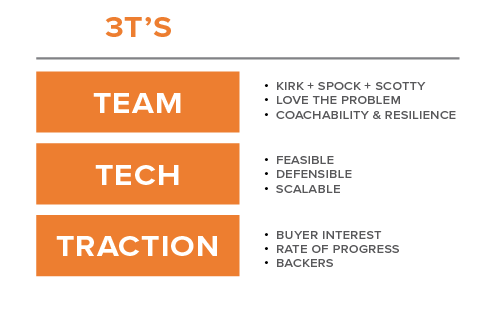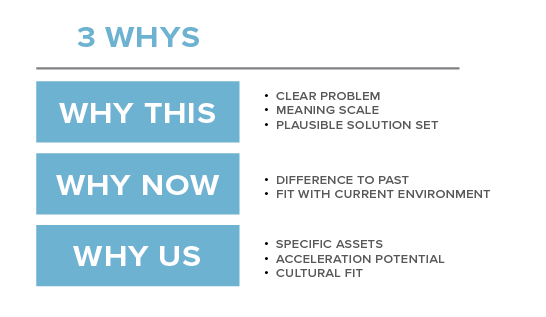All businesses need to adapt to survive and thrive, and not just in stormy times.
COVID-19 changed the business, social, and economic environment unimaginably quickly, and while storms can be a catalyst for profound innovation, the principles and tools of effective innovation are really for all seasons. This article highlights three tools that my team and I have found useful for innovating in all weathers: the 3 P’s, the 3 T’s, and the 3 Y’s.
The 3 P’s: Identifying the right problem
Every innovation needs to address a specific problem. The first step is identifying the type of problem: Is it a “critical problem,” a “tame problem,” or a “wicked problem”? The process for finding a successful solution varies greatly based on the type of problem involved. My colleague Richard Verdin has blogged in more detail about the critical/tame/wicked problem framework, but in brief:
- Critical problems have no time for analysis and require decisive, immediate action. Examples include a fire breaking out, or a core IT system suddenly going offline.
- Tame problems can be highly complicated in nature with many moving parts. Still, they are amenable to considered analysis by people with the right expertise. Examples: moving home or updating an existing life insurance product suite.
- Wicked problems are complex and messy, with many underlying variables that interact unpredictably. They may even be impossible to solve entirely, such as global warming or closing the coverage gap. The best we can do may be to make the situation somewhat better.
If you mis-categorize the problem, you will approach it the wrong way. For example, trying to solve a wicked problem with tame solutions leads to “analysis paralysis,” where lots of expensive expertise is deployed to little or no avail that could have been applied more effectively to less complex problems. Similarly, trying to solve a tame problem with a tool meant for wicked problems, such as RGAX’s Life Design Sprint process, uses up time that could be better spent working with proven experts and refining known solutions.

The 3 T’s: Identifying the right partners
Successfully identifying your “P” helps you move on to the next step of finding a partner. At RGAX, we frequently get approached by startups and entrepreneurs eager to make a positive difference to our industry. Picking the right partners is crucial in achieving our mission to help our clients grow.
A simple way to help here is to consider the 3 T’s: Team, Tech, and Traction.
- In the partner’s team, we look for a combination of instinctive business sense, analytical rigour, and operational expertise – Kirk, Spock, and Scotty for the Trekkies among you. For us, the way they engage with an underlying problem is even more important than the initial solution they develop: Solutions may need to evolve rapidly, while problems may be long-lasting. Finally, we look for a team that is receptive to feedback and resilient to the inevitable setbacks that occur whenever you try to innovate.
- The technology required for the solution is also important. Is it even feasible? And if so, is it affordable and scalable?
- Traction looks at how much headway the team has made so far in addressing the problem at hand. Have potential users of the solution shown any interest so far? How quickly has the team been able to develop their proposition? What funders have invested resources?
A partner who fits a lot of the 3 T’s is much more likely to be a good fit for us and our clients.

The 3 Y’s (Whys): Identifying the right priorities
Lastly, we use the 3 Y’s (or rather the 3 Whys) to guide our selection of projects.
- Why this? Challenging ourselves to justify investment in a particular project over others ensures we focus on problems that can be clearly defined and are important enough to have meaningful scale for RGAX and our clients. We also apply this thinking to the potential set of solutions to the problem: Is it plausible that our answers can make a measurable difference in the underlying problem?
- Why now? This is arguably the most important (and often most neglected) question when attempting any innovation. Very few ideas for solutions are completely new; almost always someone on our team, within the wider organization, or at our clients can say, “Ah yes, we tried that ten years ago – it didn’t work because…” Sometimes failure rested on a ”missing 5%” in the execution, but more often the problem can be traced back to timing. Maybe the core technology was not yet mature enough or maybe consumer expectations were not yet developed enough. So it is crucial to ask, “Why will it be different this time?”
- Why us? It is important to identify the skills or capabilities the team will bring to the solution that will make it more successful. Can the team bring a special asset such as technology or expertise? Is there a good cultural fit?
The opportunities to innovate vastly outweigh the time and resources available to do so. Using the 3 Whys helps us target finite resources where they can have the biggest impact.

Tools for any weather
While we constantly refine our existing innovation tools and discover new ones, the 3 P’s, 3 T’s and 3 Y’s have proven useful both before and after the arrival of COVID-19. I would attribute such enduring success to how these tools focus on the fundamentals of innovation: the nature of the problem you are trying to solve, the makeup of the partners you are looking to work with, and the fit of the problem within your own business.






